
The Araceae are a family of monocotyledonous flowering plants in which flowers are borne on a type of inflorescence called a spadix. The spadix is usually accompanied by, and sometimes partially enclosed in, a spathe. Also known as the arum family, members are often colloquially known as aroids. This family of 140 genera and about 4,075 known species is most diverse in the New World tropics, although also distributed in the Old World tropics and northern temperate regions.
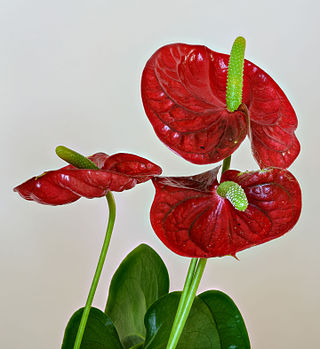
Anthurium is a genus of about 1,000 species of flowering plants, the largest genus of the arum family, Araceae. General common names include anthurium, tailflower, flamingo flower, and laceleaf.

Symplocarpus is a genus of flowering plants in the family Araceae, native to United States, Canada and eastern Asia. The genus is characterized by having large leaves and deep root systems with contractile roots used for changing the plant's level with the ground. Symplocarpus species grow from a rhizome and their leaves release a foul odor when crushed.
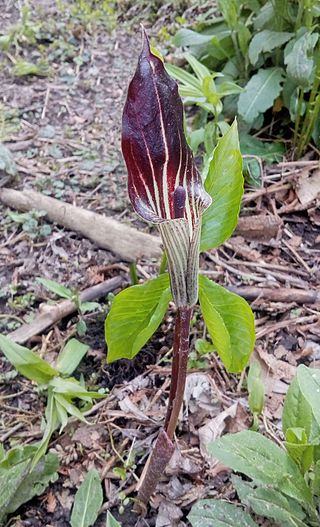
Arisaema triphyllum, the Jack-in-the-pulpit, is a species of flowering plant in the arum family Araceae. It is a member of the Arisaema triphyllum complex, a group of four or five closely related taxa in eastern North America. The specific name triphyllum means "three-leaved", a characteristic feature of the species, which is also referred to as Indian turnip, bog onion, and brown dragon.
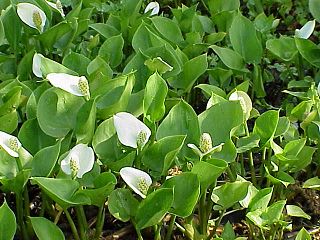
Calla is a genus of flowering plant in the family Araceae, containing the single species Calla palustris.

Ambrosina is a genus in the family Araceae that consists of only one species, Ambrosina bassii, and the only genus in the tribe Ambrosineae. This species is the smallest terrestrial aroid in the Mediterranean, growing only to 8 cm tall. It is usually found growing in woodlands on north faces of hillsides and in humus soil that is covering limestone. It is distributed in Sardinia, Corsica, Sicily, southern mainland Italy, Tunisia, and Algeria.

Asterostigma is a genus of flowering plants in the family Araceae. It is native to Brazil and Argentina. The leaves are pinnate and the plant is tuberous.
- Asterostigma cryptostylumBogner - Brasília, Goiás, Minas Gerais
- Asterostigma cubense(A.Rich.) K.Krause ex Bogner - São Paulo
- Asterostigma lividum(G.Lodd.) Engl. - southern Brazil; Misiones Province of Argentina
- Asterostigma lombardiiE.G.Gonç. - Minas Gerais, Espírito Santo
- Asterostigma luschnathianumSchott - southern Brazil
- Asterostigma reticulatumE.G.Gonç - southern Brazil
- Asterostigma riedelianum(Schott) Kuntze - eastern Brazil
- Asterostigma tweedieanumSchott - Santa Catarina in southern Brazil
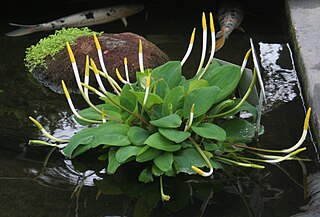
Orontium aquaticum, sometimes called golden-club, floating arum, never-wets or tawkin, is a species of flowering plants in the family Araceae. It is the single living species in the genus Orontium, which also contains several extinct species described from fossils. O. aquaticum is endemic to the eastern United States and is found growing in ponds, streams, and shallow lakes. It prefers an acidic environment. The leaves are pointed and oval with a water repellent surface. The inflorescence is most notable for having an extremely small almost indistinguishable sheath surrounding the spadix. Very early in the flowering this green sheath withers away leaving only the spadix.

Urospatha is a genus of flowering plants in the family Araceae that consists of 11 known species. They are found growing in South America and Central America in swamps, wet savannahs, and brackish water. The leaves of the species in this genus are upward pointing and sagittate (arrow-shaped). The inflorescences are quite unique; the spathe is mottled and elongated with a spiral twist at the end. The seeds are distributed by water and have a texture similar to cork that allows them to float. They also quickly germinate in water.
Podolasia is a monotypic genus of flowering plants in the family Araceae. The single known species in the genus is Podolasia stipitata. It is native to Borneo, Sumatra, and Peninsular Malaysia.

Montrichardia is a genus of flowering plants in the family Araceae. It contains two species, Montrichardia arborescens and Montrichardia linifera, and one extinct species Montrichardia aquatica. The genus is helophytic and distributed in tropical America. The extinct species M. aquatica is known from fossils found in a Neotropical rainforest environment preserved in the Paleocene Cerrejón Formation of Colombia. Living Montrichardia species have a diploid chromosome number of 2n=48.

Taccarum is a genus of flowering plants in the family Araceae. It is endemic to South America. The genus tends to grow in rocky areas.
- Taccarum caudatumRusby - Bolivia, Peru, Acre State in western Brazil
- Taccarum crassispathumE.G.Gonç. - central Brazil
- Taccarum peregrinum(Schott) Engl. - Paraguay, southern Brazil, Misiones Province of Argentina
- Taccarum uleiEngl. & K.Krause - eastern Brazil
- Taccarum warmingiiEngl. - southern Brazil
- Taccarum weddellianumBrongn. ex Schott - Bolivia, Peru, Paraguay, central and western Brazil

Typhonodorum is a monotypic genus of flowering plants in the family Araceae. The single species making up this genus is Typhonodorum lindleyanum. The genus is native to Madagascar, the Comores, Zanzibar, Réunion and Mauritius. This genus is believed to be closely related to Peltandra even though Peltandra is only found in North America and there don't appear to exist closely related genera in the African mainland. There isn't fossil evidence to link the two genera so it has been proposed that there once was a genus in Africa from which the two genera had originated. The African mainland genus spread to North America and to Madagascar 50 million years ago before it broke off. Then the African genus became extinct and the North American and Madagascan genera remained.
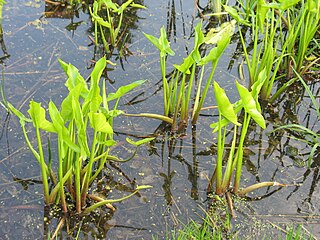
Peltandra virginica is a plant of the arum family known as green arrow arum and tuckahoe. It is widely distributed in wetlands in the eastern United States, as well as in Quebec, Ontario, and Cuba. It is common in central Florida including the Everglades and along the Gulf Coast. Its rhizomes are tolerant to low oxygen levels found in wetland soils. It can be found elsewhere in North America as an introduced species and often an invasive plant.
Peltandra primaeva is an extinct species of monocot in the family Araceae known from a Ypresian age Eocene fossil found in western North Dakota, USA.
Peltandra sagittifolia is a species of plant in the genus Peltandra. It is commonly known as the spoonflower or the white arrow arum, native to the southeastern United States from eastern Louisiana to eastern Virginia.

Smilax laurifolia is a species of flowering plant in the greenbrier family known by the common names laurel greenbrier, laurelleaf greenbrier, bamboo vine, and blaspheme vine. It is native to the southeastern United States, where it occurs along the Gulf and Atlantic coastal plains from Texas to New Jersey, the range extending inland to Arkansas, Oklahoma, and Tennessee. It also occurs in Cuba and the Bahamas.

Montrichardia arborescens, the yautia madera, or moco-moco, is a tropical plant grows along river banks, swamps, or creeks to a maximum height of 9'. They consist of arrow shaped leaves that are food sources for animal species. The plant produces inflorescences which then leave a fruit of Montrichardia arborescens which is edible and can be cooked. Its fruiting spadices produces large infructescences, which contain about 80 edible yellow fruits.
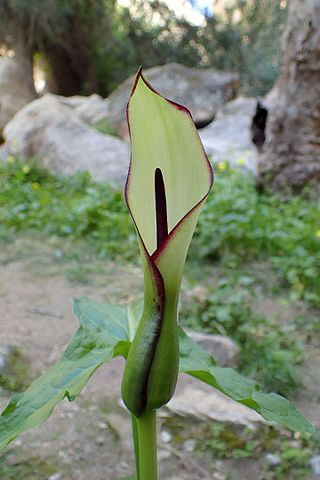
Arum hygrophilum is a species of flowering plant in the family Araceae. It has a disjunct distribution, found in Israel, Jordan, Lebanon, Syria, Cyprus and Morocco.

Peltandreae is a tribe of plants in the arum family.

















